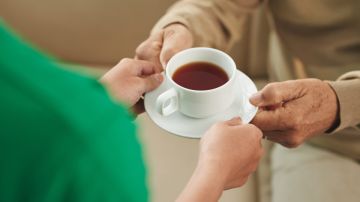Today’s Millennial Latinas Are Facing The Challenges Of Caregiving
For many of us, when we think caregivers the immediate image that comes to mind is a middle aged person in their 40s or 50s watching after an elderly parent

Photo: 123rf
For many of us, when we think caregivers the immediate image that comes to mind is a middle aged person in their 40s or 50s watching after an elderly parent. But a new report by AARP will completely change the way you’ve thought about caregivers. New research shows that around 10 million Americans between ages 18 and 34 are now the caregivers for a family member or even friend and many of these U.S. millennial caregivers are Latinas.
According to the 2015 Caregiving in the U.S. study by AARP and the National Alliance for Caregiving, 27% of millennial caregivers are Hispanic. Around 18% are black, 8% are Asian American/Pacific Islanders and 44% are white. What’s especially interesting about these new findings are that the majority of these caregivers who are now looking after their baby boomer parents and relatives are also balancing their demanding careers with caregiving. That’s a lot of responsibility to fall on one person. They also lack a lot of the resources and information needed to balance working a full-time job with close to 21 hours per week dedicated to caregiving.
In fact, the study claims that Latinx millennial caregivers actually face more intense pressure to balance employment and caregiving than other millennials.
“The most surprising data revealed in this report was the amount of time and the level of complex care millennial caregivers are providing to their loves ones on a daily basis,” Yvette Peña, Vice President of AARP Multicultural Leadership Hispanic/Latino Audience Strategy told HipLatina. “Hispanic millennial caregivers face more intense pressure to balance employment and caregiving than do other millennial caregivers. According to AARP’s findings, they spend more time working on average (42 hours per week) than [their ] White or African American/Black counterparts. Moreover, the report found that Hispanic millennial caregivers more frequently provide higher-hour levels of family care than other groups.”
The study suggests that this could be because a lot of Latinx caregivers live in multi-generational households but this isn’t always the case. Regardless, caregiving can be challenging in many ways, not just in terms of balance but also financially. According to the study, a caregiver spends an average of 27% of their income on caregiving, which is a lot especially if that millennial is earning less than $50,000 a year. On top of that, many millennials have a large amount of debt especially if they have student loans, which roughly 70% of college grads have.
Peña explains that because the number of millennial caregivers is increasing and will continue to trend up, “the demand for tools and resources that meet the needs of multicultural families will rise with a greater need for flexible and supportive workplace leave polices.”
Rocío Guzman, is a 31-year-old Dominican woman from Santiago, Dominican Republic who currently lives in NYC. She works as a publicist at a non-profit organization and is also responsible for watching after her 92-year-old great-grandmother, Carmen Hiraldo, who raised her and took care of her since she was an infant. Hiraldo was once Guzman’s legal guardian and now Guzman watches after Hiraldo.
“I started taking care of her naturally,” Guzman tells us. “She always took care of me and in the past few years the tables have kind of turned. However, I don’t look at it as taking care of her—it just is what comes naturally to me. I’ve never felt comfortable with the concept of having a home aid (a stranger take care of her). So over the years, as things have gotten harder for her to do on her own, like taking out the trash, cleaning, laundry—I’ve just started to do them for her.”
But it’s not easy. Aside from working a full-time job, Guzman also has to modify certain aspects of her life in order to properly look after her abuela and that often times means less socializing.
“It’s had an impact. Because of her old fashioned ways more than anything really,” Guzman says. “I don’t hang out as much as a regular 31-year-old might. I often have to head to her house to make sure things are in place and that she’s alright. Simple tasks like taking a shower are now something we have to be very careful about.” Fortunately, for Guzman she sees it more as a blessing than a burden. “I don’t mind it though. It gives me more time to hang with her and keep her company.”
For actress and host of Univision 34, Nitzia A. Chama Villa, balancing a very demanding career in television and taking care of her abuelos has certainly come with it’s fair share of challenges. Villa was born and raised in Xalapa, Veracruz, Mexico and has been living in Los Angeles for seven years.
“My maternal grandparents have lived in this city for more than 30 years. As a child I always spent my vacations here to visit them. Now that I live here in the same city they have become my greatest joy and also the most important responsibility,” she tells HipLatina.
Finding the right resources, tools, and information wasn’t an easy task initially. “At first I felt I lacked information. And this is how I have gradually approached programs for seniors and learned how I can help my grandparents and make sure they are better served and that their health always be our priority,”
Villa’s abuelos are both already in their 80s and because of it their needs have only increased. But fortunately, they are still relatively independent. “My grandpa is diabetic and has the beginning stages of Parkinson’s. On the other hand, my grandma is the strongest woman I know. She is very active,” Villa says. “She cooks, does the laundry etc. and she is in charge of giving the medication to my grandpa, which we pick up periodically at their health center.”
Villa took on the role of her grandparents caregivers because she’s the only grandchild or child that lives in the same city as them. Most of the family lives in New York, Texas or Long Beach. And her mother lives in Mexico. She doesn’t actually live with with her grandparents though.
“I do not live with them because of my work and the distances in L.A.,” she says. “But in order to be aware of them physically and emotionally, my visiting them is essential. Every time I arrive at their house their faces automatically light up and we begin a routine of talking about all the new things that have happened. My grandpa steps out to walk for a bit while my grandma gives [and makes] the most delicious food imaginable. And while we watch TV, we talk about their medication and they show me the letters they receive over the mail so that I could translate them and tell them about the information the government sends them.”
Being a caregiver is a huge responsibility that can greatly impact someone’s emotional and mental health, which is why it’s so important for Villa to make sure she’s taking care of herself first.
“You always have to be good with yourself before you can help or serve someone else. So I try to keep my emotions well balanced before I see them because I wouldn’t want to share negative situations or feelings with them,” she says. “On the contrary, I always arrive cheerful and with a spirit of love so that they get infected with happiness and we can enjoy each day that God gives us together.”
One of the advantages of millennials being the caregivers of their generation is their need and drive to obtain information. “Millennials are the generation most likely to use caregiving-related information and also are the most likely to want more information than they already have,” says Peña. “There is still a learning curve for previous generations. For that reason, we provide support that is face-to-face and in written form through a number of publications that can be requested through calling our toll-fee number 1-877-333-5885 in English or 1-888-971-2013 in Spanish.”
Peña emphasizes what hasn’t changed: the role of the Latina as a caregiver for her loved ones.
“In fact, in a previously related AARP 2016 study focused on the costs of caregiving, it found that among Hispanic caregivers taking care of recipients aged both 18+ and 50+, there is a pronounced female skew,” she says. “[Around] 58% of all Hispanic caregivers taking care of persons aged 18 and over are women. Sixty-three percent of all Hispanic caregivers taking care of persons aged 50 and over are women and when the Hispanic caregiver segment aged 18-49 considered, this level rises to 68%. Thus, Hispanic females aged 18-40 shoulder the greatest level of responsibility for caregiving, among all the Hispanic caregiving segments.”

















